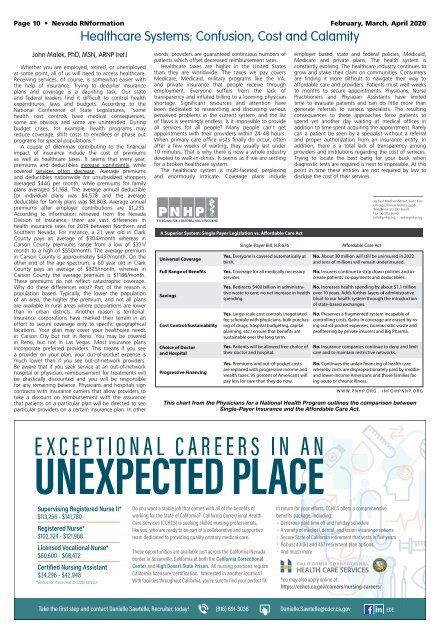Nevada RN - February 2020
- No tags were found...
You also want an ePaper? Increase the reach of your titles
YUMPU automatically turns print PDFs into web optimized ePapers that Google loves.
Page 10 • <strong>Nevada</strong> <strong>RN</strong>formation <strong>February</strong>, March, April <strong>2020</strong><br />
Healthcare Systems: Confusion, Cost and Calamity<br />
John Malek, PhD, MSN, A<strong>RN</strong>P (ret.)<br />
Whether you are employed, retired, or unemployed<br />
at some point, all of us will need to access healthcare.<br />
Receiving services, of course, is somewhat easier with<br />
the help of insurance. Trying to decipher insurance<br />
plans and coverage is a daunting task. Our state<br />
and federal leaders find it difficult to control health<br />
expenditures, laws and budgets. According to the<br />
National Conference of State Legislatures, “some<br />
health cost controls have medical consequences;<br />
some are obvious and some are unintended. During<br />
budget crises, for example, health programs may<br />
reduce coverage, shift costs to enrollees or phase out<br />
programs for special populations.”<br />
A couple of dilemmas contributing to the financial<br />
impact of insurance include the cost of premiums<br />
as well as healthcare taxes. It seems that every year,<br />
premiums and deductibles increase significantly, while<br />
covered services often decrease. Average premiums<br />
and deductibles nationwide for unsubsidized shoppers<br />
averaged $440 per month, while premiums for family<br />
plans averaged $1,168. The average annual deductible<br />
for individual plans was $4,578 and the average<br />
deductible for family plans was $8,803. Average annual<br />
premiums after employer contributions are $1,235.<br />
According to information retrieved from the <strong>Nevada</strong><br />
Division of Insurance, there are vast differences in<br />
health insurance rates for 2019 between Northern and<br />
Southern <strong>Nevada</strong>. For instance, a 21 year old in Clark<br />
County pays an average of $304/month whereas in<br />
Carson County premiums range from a low of $331/<br />
month to a high of $550/month. The average premium<br />
in Carson County is approximately $437/month. On the<br />
other end of the age spectrum, a 60 year old in Clark<br />
County pays an average of $825/month, whereas in<br />
Carson County the average premium is $1186/month.<br />
These premiums do not reflect catastrophic coverage.<br />
Why do these differences exist? Part of the reason is<br />
population based. Typically, the lower the population<br />
of an area, the higher the premium, and not all plans<br />
are available in rural areas where populations are lower<br />
than in urban districts. Another reason is territorial.<br />
Insurance corporations have marked their terrain in an<br />
effort to secure coverage only to specific geographical<br />
locations. Your plan may cover your healthcare needs<br />
in Carson City but not in Reno. You may be covered<br />
in Reno, but not in Las Vegas. Most insurance plans<br />
incorporate preferred providers. This means if you see<br />
a provider on your plan, your out-of-pocket expense is<br />
much lower than if you see out-of-network providers.<br />
Be aware that if you seek service at an out-of-network<br />
hospital or physician, reimbursement for treatments will<br />
be drastically discounted and you will be responsible<br />
for any remaining balance. Physicians and hospitals sign<br />
contracts with insurance carriers that allow providers to<br />
take a discount on reimbursement with the assurance<br />
that patients on a particular plan will be directed to see<br />
particular providers on a certain insurance plan. In other<br />
words, providers are guaranteed continuous numbers of<br />
patients which offset decreased reimbursement rates.<br />
Healthcare taxes are higher in the United States<br />
than they are worldwide. The taxes we pay covers<br />
Medicare, Medicaid, military programs like the VA,<br />
and private insurance that people receive through<br />
employment. Everyone suffers from the lack of<br />
transparency and inflated billing to a looming physician<br />
shortage. Significant resources and attention have<br />
been dedicated to researching and discussing various<br />
perceived problems in the current system, and the list<br />
of flaws is seemingly endless. Is it impossible to provide<br />
all services for all people? Many people can’t get<br />
appointments with their providers within 24-48 hours.<br />
When primary care office visits finally do occur, often<br />
after a few weeks of waiting, they usually last under<br />
10 minutes. That is why there is now a whole industry<br />
devoted to walk-in-clinics. It seems as if we are settling<br />
for a broken healthcare system.<br />
The healthcare system is multi-faceted, perplexing<br />
and enormously intricate. Coverage plans include<br />
employer based, state and federal policies, Medicaid,<br />
Medicare and private plans. The health system is<br />
constantly evolving. The healthcare industry continues to<br />
grow and stake their claim on communities. Consumers<br />
are finding it more difficult to navigate their way to<br />
affordable care and providers. Patients must wait weeks<br />
to months to secure appointments. Physicians, Nurse<br />
Practitioners and Physician Assistants have limited<br />
time to evaluate patients and can do little more than<br />
generate referrals to various specialists. The resulting<br />
consequences to these approaches force patients to<br />
spend yet another day waiting at medical offices in<br />
addition to time spent acquiring the appointment. Rarely<br />
can a patient be seen by a specialist without a referral<br />
and proper authorization from an insurance entity. In<br />
addition, there is a total lack of transparency among<br />
providers and institutions regarding the cost of services.<br />
Trying to locate the best bang for your buck when<br />
diagnostic tests are required is next to impossible. At this<br />
point in time these entities are not required by law to<br />
disclose the cost of their services.<br />
This chart from the Physicians for a National Health Program outlines the comparison between<br />
Single-Payer Insurance and the Affordable Care Act.

















